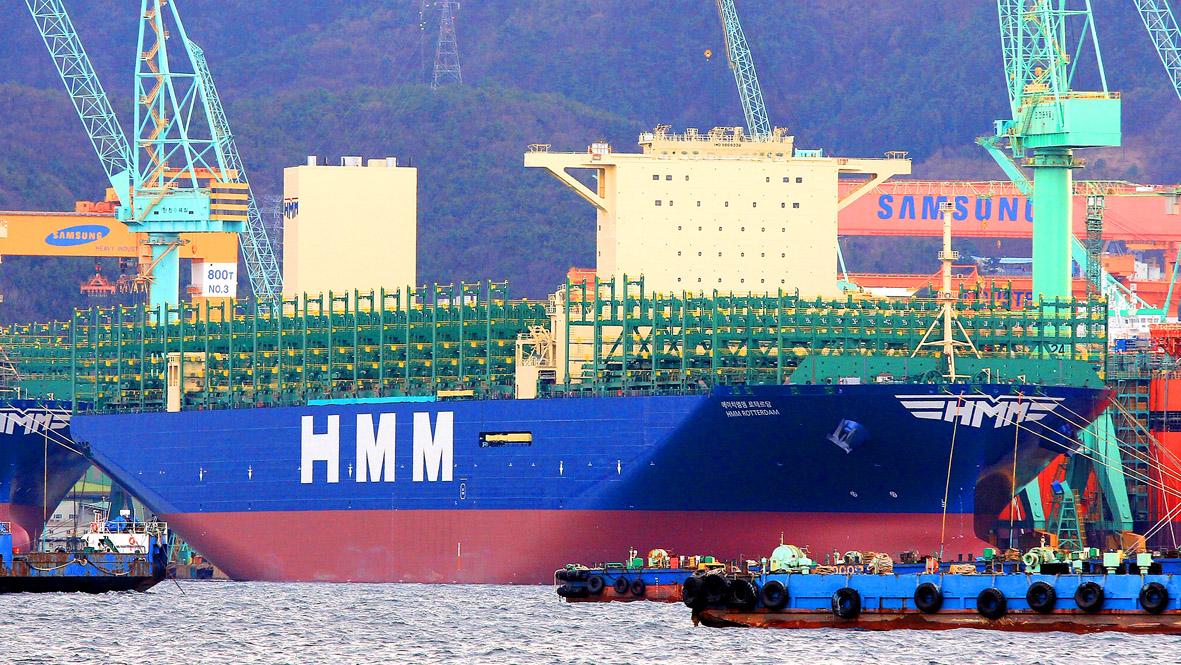Export orders continued a winning streak last month, which helped second-quarter orders grow year-on-year, ending six consecutive quarters of declines, the Ministry of Economic Affairs said yesterday.
Export orders — a critical gauge of how actual exports are likely to perform in the following one to three months — grew 6.5 percent year-on-year and 5.4 percent month-on-month to US$41 billion last month, the ministry said.
This was the fourth straight month that orders have been in the black, which Department of Statistics Director Huang Yu-ling (黃于玲) attributed to strong demand for electronic products and rising oil and steel prices.

Photo courtesy of Taiwan International Ports Corp
Orders for the second quarter increased 3.1 percent from a year earlier to US$118.42 billion, 13.6 percent higher than the previous quarter, ministry data showed.
However, cumulative orders for the first half of the year decreased 0.1 percent year-on-year to US$222.66 billion, the data showed.
Due to the COVID-19 pandemic, demand for work-from-home and distance learning-related electronics has skyrocketed, pushing orders for information communications products such as laptops, tablets and servers up 17.1 percent annually to US$13.0 billion last month, although they declined 0.2 percent from May.
Huang said she expects demand for such products to remain strong this month as COVID-19 continues to spread worldwide.
Demand for electronics products such as wafers, memory chips and printed circuit boards were also strong, with orders increasing 23.9 percent year-on-year to US$12.3 billion and 9.2 percent from May, the data showed.
Demand for optical equipment such as flat panels picked up and prices stopped falling, resulting in US$1.9 billion in orders, 3.8 percent growth year-on-year and a 4.8 percent increase month-on-month, the data showed.
Orders for mechanical equipment, petrochemical products and chemicals have been hit hard amid the pandemic, but Huang said that a steady rise in oil and steel prices has mitigated the downward trend.
While oil prices have been on an upward trend since April, they were still 41.1 percent lower than a year earlier last month, the ministry said.
Last month, orders for mechanical products fell 5.1 percent annually, but rose 3.1 percent monthly to US$1.6 billion, petrochemical orders dropped 10 percent year-on-year, but expanded 10.2 percent month-on-month to US$1.6 billion, and chemical product orders decreased 20.1 percent from a year earlier, but increased 8.2 percent from the previous month to US$1.3 billion, the data showed.
US orders increased 13.6 percent year-on-year to US$13.3 billion last month, orders from China, including Hong Kong, rose 13 percent to US$10.6 billion and European orders advanced 10.8 percent to US$7.5 billion, the data showed.
Despite last month’s orders beating expectations, Huang said that she is only “cautiously optimistic” about the numbers for this month, as uncertainties abound.
“We hope the demand for work-from-home devices will still be strong and growth in oil and steel prices will remain steady, but the COVID-19 situation in the US, South America and India has not stabilized,” she said.

Taiwan Transport and Storage Corp (TTS, 台灣通運倉儲) yesterday unveiled its first electric tractor unit — manufactured by Volvo Trucks — in a ceremony in Taipei, and said the unit would soon be used to transport cement produced by Taiwan Cement Corp (TCC, 台灣水泥). Both TTS and TCC belong to TCC International Holdings Ltd (台泥國際集團). With the electric tractor unit, the Taipei-based cement firm would become the first in Taiwan to use electric vehicles to transport construction materials. TTS chairman Koo Kung-yi (辜公怡), Volvo Trucks vice president of sales and marketing Johan Selven, TCC president Roman Cheng (程耀輝) and Taikoo Motors Group

Among the rows of vibrators, rubber torsos and leather harnesses at a Chinese sex toys exhibition in Shanghai this weekend, the beginnings of an artificial intelligence (AI)-driven shift in the industry quietly pulsed. China manufactures about 70 percent of the world’s sex toys, most of it the “hardware” on display at the fair — whether that be technicolor tentacled dildos or hyper-realistic personalized silicone dolls. Yet smart toys have been rising in popularity for some time. Many major European and US brands already offer tech-enhanced products that can enable long-distance love, monitor well-being and even bring people one step closer to

RECORD-BREAKING: TSMC’s net profit last quarter beat market expectations by expanding 8.9% and it was the best first-quarter profit in the chipmaker’s history Taiwan Semiconductor Manufacturing Co (TSMC, 台積電), which counts Nvidia Corp as a key customer, yesterday said that artificial intelligence (AI) server chip revenue is set to more than double this year from last year amid rising demand. The chipmaker expects the growth momentum to continue in the next five years with an annual compound growth rate of 50 percent, TSMC chief executive officer C.C. Wei (魏哲家) told investors yesterday. By 2028, AI chips’ contribution to revenue would climb to about 20 percent from a percentage in the low teens, Wei said. “Almost all the AI innovators are working with TSMC to address the

Malaysia’s leader yesterday announced plans to build a massive semiconductor design park, aiming to boost the Southeast Asian nation’s role in the global chip industry. A prominent player in the semiconductor industry for decades, Malaysia accounts for an estimated 13 percent of global back-end manufacturing, according to German tech giant Bosch. Now it wants to go beyond production and emerge as a chip design powerhouse too, Malaysian Prime Minister Anwar Ibrahim said. “I am pleased to announce the largest IC (integrated circuit) Design Park in Southeast Asia, that will house world-class anchor tenants and collaborate with global companies such as Arm [Holdings PLC],”